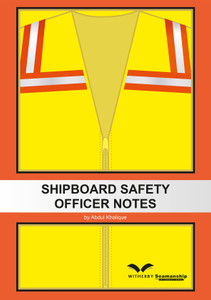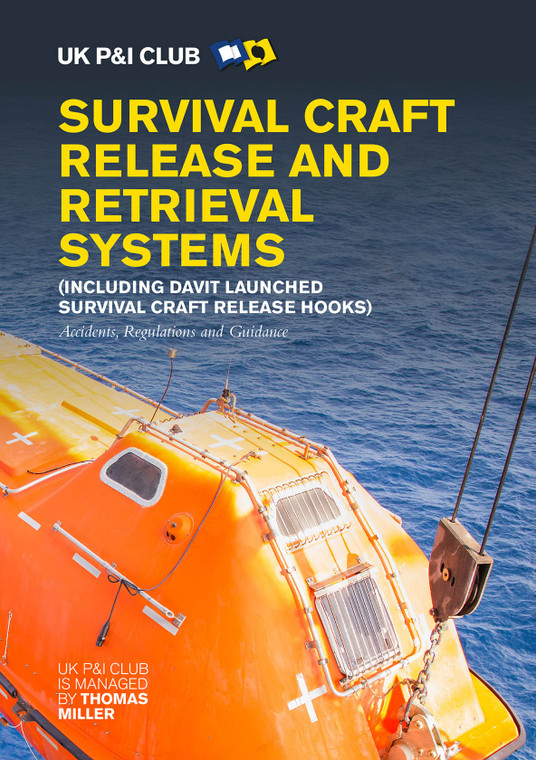
Written by the UK P&I Club, this contains up to date guidance on lifeboat safety and includes summaries of major regulations, lifeboat accident case studies and a lifeboat launch and recovery checklist.
Accidents involving survival craft are a leading cause of injuries and fatalities at sea. This publication raises awareness of the hazards associated with survival craft and release systems and provides guidance on their safe operation.
The book summarises the major regulatory requirements for survival craft release and retrieval systems and looks at the causes of a number of lifeboat accidents. It sets out best practice for lifeboat operations and for maintenance and repair of lifeboats and related appliances.
The lifeboat launch and recovery checklist is based on an analysis of common faults in accidents and is derived from multiple guidance sources within the industry. It leads the operator through every step of lifeboat operation, including planning, equipment checks, operational checks and recovery procedure. It should be used in conjunction with manufacturer’s recommendations and company procedures.
Accidents involving survival and rescue craft are a continuing source of concern within the maritime industry. Various regulatory amendments have been made in recent years, many of which have addressed onload release mechanisms in an attempt to prevent further occurrences.
However, despite numerous regulatory changes, accidents continue to occur. Two high profile accidents took place in 2016. The first, on board the ‘Norwegian Breakaway’ in July, led to 1 death and 3 injuries. The second, in September on board the ‘Harmony of the Seas’ led to 1 death and 4 injuries. Both incidents were as a result of unexpected release during a drill.
Lifeboat accidents occur most often during training and drills and involve not just the hooks, but also the entire lifeboat release and retrieval system (LRRS), including the wires, the gripes and pennants. In many cases, the cause is unsound procedures.
Identified causes of lifeboat accidents include:
- Lack of adequate training and knowledge
- unfamiliarity with equipment
- inadequate risk assessment and planning
- systems that are not yet modified in accordance with SOLAS Regulation III/1.5
- systems with design issues
- incorrectly or poorly maintained systems
- communication problems
- complacency and failure to follow safety procedures.
An April 2016 study, by the Seafarers International Research Centre, reflected that design issues identified in lifeboat systems critically impacted on the attitudes of seafarers, leading to considerable fear and a loss of faith in carrying out drills. The report cited that fear of the equipment, knowledge of previous accidents and difficulties of the ship’s schedule in allowing frequent drills all contributed to a reluctance that exacerbated the problem of training for safety.
Analysis of the case studies shows that almost all of the incidents involved qualified seafarers. It is essential, therefore, that the safety lessons learned from accidents involving lifeboat systems are passed on both to those serving at sea and to management ashore. An awareness of the current regulatory requirements and the available guidance concerning the use of lifeboats is important, as it ensures that appropriate onboard procedures and training are applied and followed.
Chapter 1 – Introduction
Chapter 2 – Lifeboat Accidents
2.1 ‘Hoegh Duke’ – 20 August 1992
2.2 ‘Kayax’ – 9 August 1994
2.3 ‘Iolcos Grave’ – 9 November 1998
2.4 ‘European Highway’ – 1 December 2000
2.5 ‘Gulser Ana’ – 17 October 2001
2.6 ‘Galateia’ – 26 January 2002
2.7 ‘Lowlands Grace’ – 7 October 2004
2.8 ‘Sea Urchin’ – 22 May 2006
2.9 ‘Valparaiso Star’ – 28 August 2007
2.10 ‘Louise Russ’ – 3 January 2011
2.11 ‘CMA CGM Christophe Colomb’ – 15 April 2011
2.12 ‘Anna Maersk’ – 27 March 2012
2.13 ‘Thomson Majesty’ – 10 February 2013
2.14 ‘Aquarosa’ – 1 March 2014
2.15 ‘Nagato Reefer’ – 9 April 2014
2.16 ‘Westport’ – 21 November 2014
2.17 ‘Thomson Celebration’ – 10 June 2015
2.18 ‘Dorikos’ – 27 August 2015
2.19 IMCA Safety Flash – October 2015
2.20 MV ‘Amazon’ – 12 April 2016
2.21 ‘Harmony of the Seas’ – September 2016
Chapter 3 – Regulations
3.1 Origins of Lifeboat Release Regulations
3.2 1980 – On-Load Release Hooks
3.3 2001 – Investigation into Accidents involving Lifeboats and their Launching Systems
3.4 2002 – High Number of Accidents with Lifeboats Discussed at MSC
3.5 2006 – Improvement to Manuals Required to Address Lifeboat Release Gear Concerns
3.6 2008 – ‘Survival Craft’ Booklet
3.7 2009 – Use of Fall Preventer Devices (FPDs)
3.8 2009 – Port State Control (PSC)
3.9 2010 – Sub-Committee on Ship Design and Equipment (DE) Agrees Guidelines to Replace Unsafe Lifeboat Release Mechanisms
3.10 2011 – Amendments to SOLAS, LSA Code and New Guidance
3.11 2013 to 2016 – IMO Regulations as Now Applicable
Chapter 4 – Guidance
4.1 Common Problems with Hook Systems
4.2 Measures to Prevent Accidents with Lifeboats (MSC.1/Circ.1206)
4.3 Guidelines for the Fitting and Use of Fall Preventer Devices (FPDs) (MSC.1/Circ.1327)
4.4 Requirements for Maintenance, Thorough Examination, Operational Testing, Overhaul and Repair of Lifeboats and Rescue Boats, Launching Appliances and Release Gear (Resolution MSC.402(96))
4.5 Summary of the Guidance
Chapter 5 – Lifeboat Launch and Recovery Checklist
Witherby Publishing Group Ltd
Witherbys titles are developed using scripts developed by technical experts that are peer reviewed within work groups. Typically, they seek to improve understanding of the regulations, recommendations and guidelines issued by Industry.
Witherbys staff have significant expertise in the fields of navigation and hazardous cargoes as well as in the presentation of complex subjects in a graphic and easy to understand manner.
The UK P&I Club
The UK P&I Club is one of the oldest P&I clubs in the world. It has endured for a century and a half with its continuing focus on mutuality. The UK Club has remained constant, weathering periods of profound economic and political change.
Providing a superior service to members at cost has always been the Club’s central purpose. Irrespective of the times, staying true to our specialist role has demanded rigorous financial control.
Our loss prevention department was one of the earliest in the P&I business, and it remains the most extensive, helping to reduce members’ exposure to claims. Other modern initiatives include the in-depth analysis of major claims, conducting onboard risk assessments and sharing training videos with seafarers and shore personnel on lessons learned, drawn from our database. Since the era of the mid-Victorian tramp steamer, the UK P&I Club has looked ahead with its members. The past has enabled us to help prepare the maritime world for future challenges.
For a safer tomorrow at sea, we are championing best industry practice and investing in innovation. The UK P&I Club will continue to focus on what it does best: protecting shipping globally, together.
- Number of Pages:
- 70
- ISBN:
- 9781856097420
- Binding Format:
- Paperback
- Book Height:
- 235 mm
- Book Width:
- 155 mm
- Weight:
- 0.4 kg
- Author:
UK P&I Club
- Published Date:
- August 2017
- Preview:
- Yes
- Publication Date:
- August 2017





